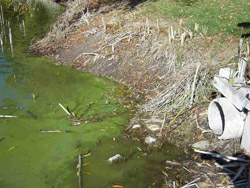Algal blooms
What is an algal bloom?

Occasionally, algae can grow very fast or ‘bloom’ into thick, visible patches near the surface of the water. Blooms do occur naturally, but excessive nutrients and certain environmental conditions can cause larger growth.
Some blooms may be referred to as ‘red tides’ because of their colour while other can look like a green mat or even an oily sheen.
What are algae and ‘blue-green algae’?
Algae are plants with a very simple cell structure, are mostly aquatic (living on, in or near water) and usually very small (microscopic) in size.
However, some can form visible filaments (strings) and mats and some can grow quite large and appear plant-like (for example, kelp). Some algae may float or attach to rocks, shells, and other plants.
Blue-green algae, known as cyanobacteria, are actually an aquatic type of bacteria. They are microscopic but can create visible scums. They are a natural part of our rivers, marine environments and estuaries (where freshwater from rivers and streams flow into the ocean).
How can I tell if there is an algal bloom?
Signs that may indicate that there is an algal bloom include:

- brightly coloured water
- blue-green scums on the water surface
- coloured stringy filaments in the water or on the surface
- brown discoloured water
- oily films on the water surface.
If you notice any of these signs it is recommended that you do not enter the water until the situation has been clarified. It should be noted that some algal blooms may not affect how the water looks.
Are algal blooms a health hazard?
Most types of algae do not cause health problems, but some algal blooms can be a public health threat. Contact with an algal bloom may cause a number of health problems including:

- skin rashes
- eye irritation and redness
- earaches
- itchiness
- swollen lips
- hay fever symptoms
- asthma
- possible skin tumours
- Gastroenteritis
- neurological effects.
Certain types of algae can also produce toxins (poisons) that can contaminate shellfish and make them unsafe to eat. Find out more about the risks of collecting wild shellfish.
Large numbers of dead fish (fish kills) can also occur when algal blooms decrease the level of oxygen in a water way. Dead fish should not be collected to eat or be fed to pets.
If you have been exposed to an algal bloom, wash off any of the plant material.
Seek medical advice if you suffer any reaction from the contact or from consuming wild shellfish.
Testing for algal blooms?
The Department of Biodiversity, Conservation and Attractions (external site) test the Swan and Canning Rivers for algae and provide a summary of these monitoring results to the Department of Health.
The Department of Water and Environmental Regulation (external site) tests a number of waterways in Western Australia for algae and provide moitoring results to the Department of Health.
Certain local governments also undertake algal testing in response to algal blooms in constructed lakes and other water bodies. There are also several other agencies which have responsibility for certain water bodies e.g., dams/reservoirs which undertake algal testing.
When are waterways tested?
Testing programs vary but generally occur from early spring through to late autumn when harmful algal blooms are most common.
There are however several water bodies which are monitored and tested through-out the year which include for example the Swan and Canning Rivers and the Lower Vasse River.
Monitoring cannot be carried out in all waterways. Just because one part of a waterway is free of an algal bloom at a particular time, it does not mean that another part of the waterway will not be affected.
What is the water tested for?
Water samples are tested for different types of algae and blue-green algae and their levels. The results of the tests are compared with nationally approved guidelines to determine the risk to the public health.
Public health warnings
The Department of Health will provide information directly or via local government authorities if it considers an algal bloom may pose a health risk to people. Public warnings may be issued via television, radio, local or regional newspapers, social media and online.
Prominent health warning signs are usually placed in areas where people commonly access the water. Look for these warning signs and follow the advice.
Local government environmental health officers will also be able to advise of algal bloom warnings for local waterways. Find out how to contact local government (external site).
You can also check the following websites:
Swan and Canning Rivers health advice
The FAQs below are in relation to toxic Alexandrium algal blooms which have previously impacted the Swan and Canning Rivers.
Lower Vasse River health advice
The fact sheet below provides general health advice regarding cyanobacterial (blue-green algae) blooms that commonly occur on the Lower Vasse River in Busselton.
What if I think there may be an algal bloom?
Contact the following agencies if you think there is an algal bloom in a waterway:
Last reviewed: 02-01-2024
Acknowledgements
Environmental Health Directorate, Public Health
This publication is provided for education and information purposes only. It is not a substitute for professional advice. Information about a service, product or treatment does not imply endorsement and is not intended to replace professional advice. Readers should note that over time currency and completeness of the information may change. All users should seek advice from a qualified professional for answers to their questions.